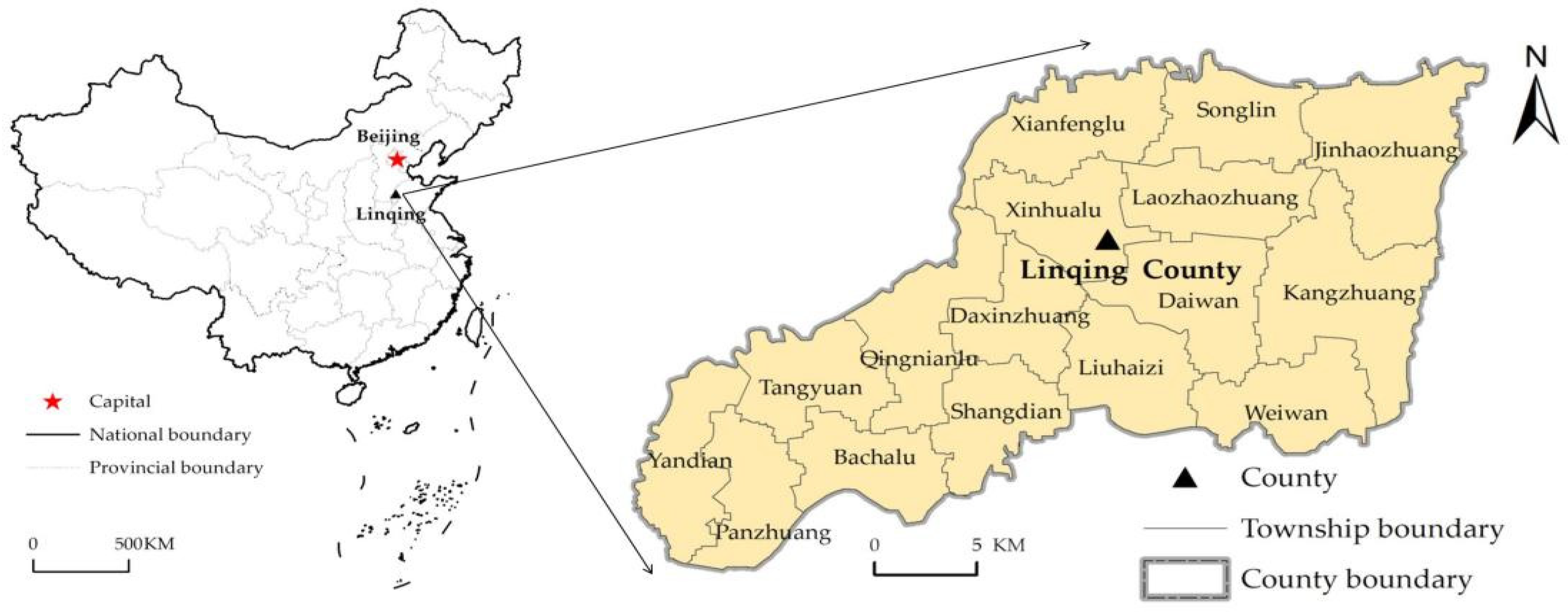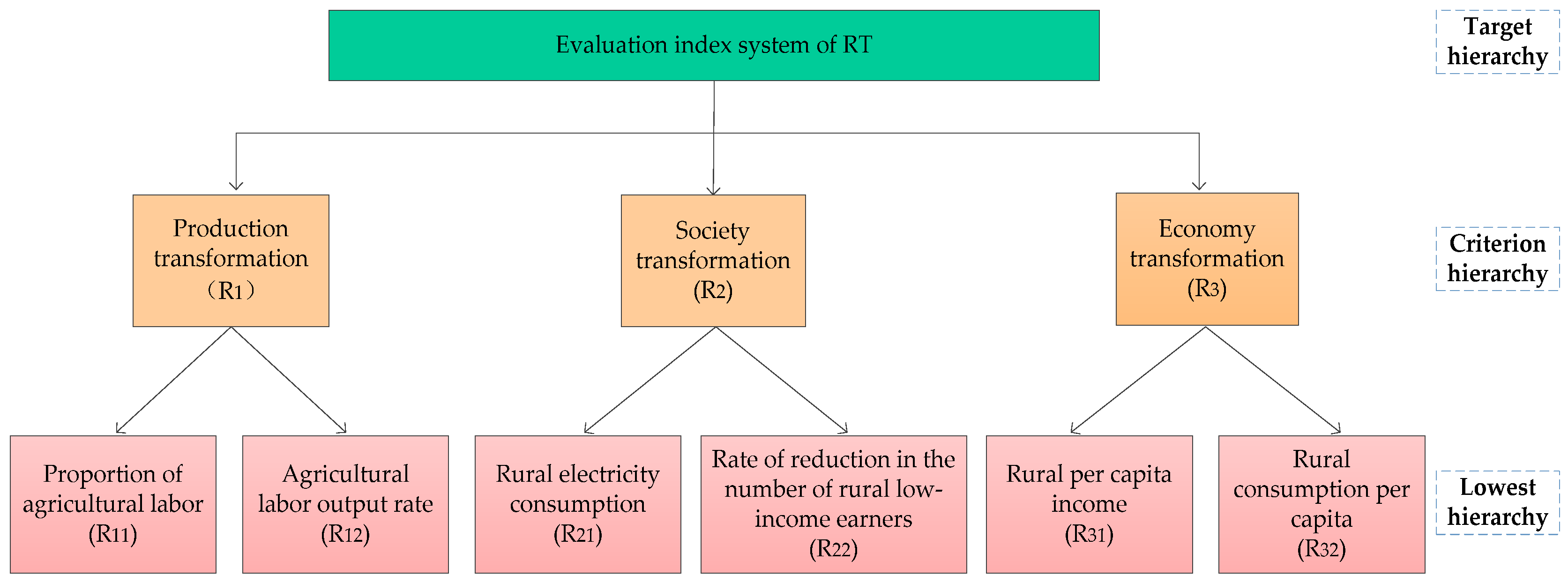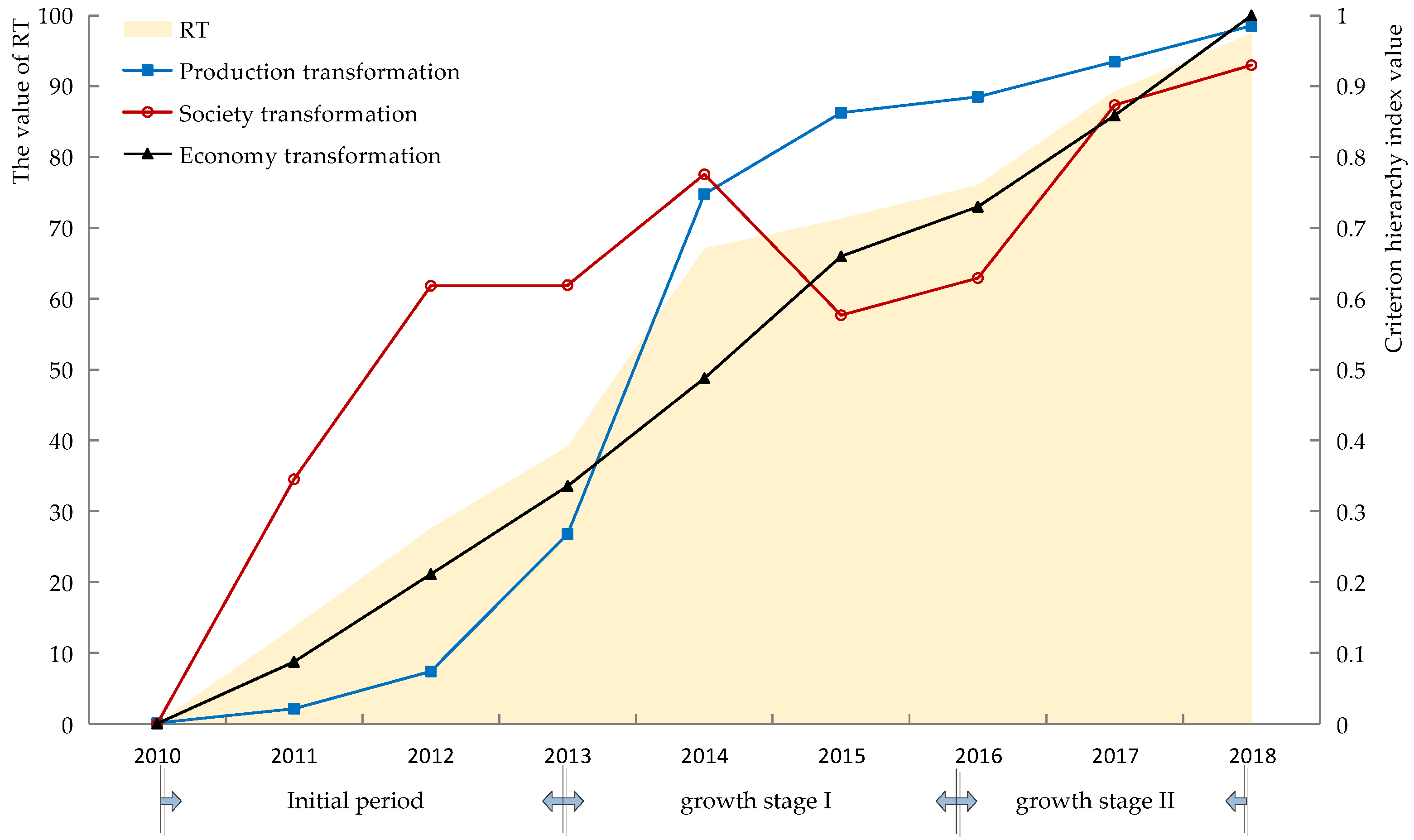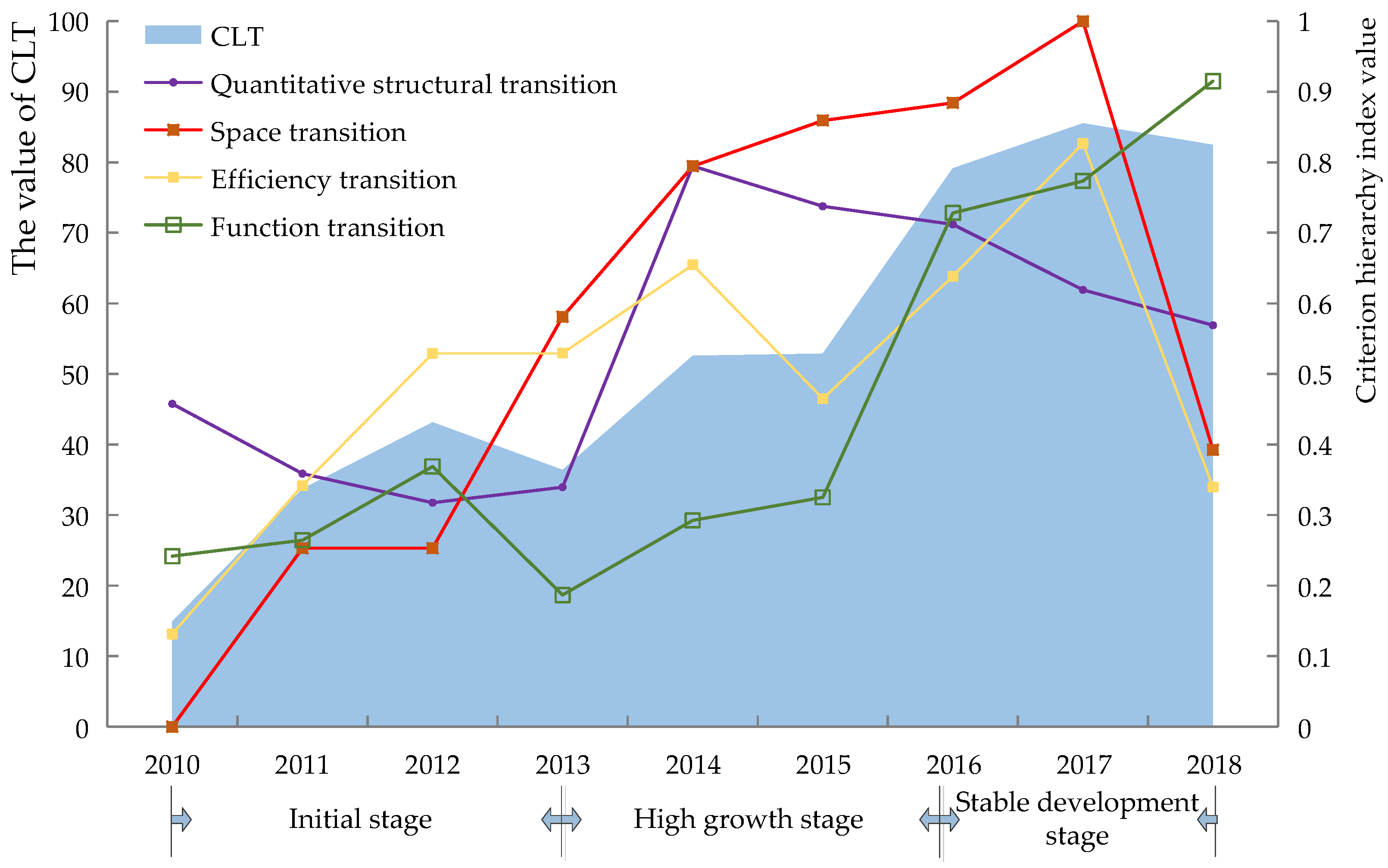How Is Construction Land Transition Related to Rural Transformation? Evidence from a Plain County in China Based on the Grey Correlation Model
Abstract
:1. Introduction
2. Literature Review and Theoretical Framework
2.1. Literature Review
2.2. Theoretical Framework
3. Study Area and Data Sources
3.1. Study Area
3.2. Data Sources
4. Methodology
4.1. Methodology and Logic
4.2. The Multi-Factor Comprehensive Evaluation Method
4.2.1. Construction of Evaluation Index System for RT and CLT
4.2.2. Determination of Weights of Evaluation Indicators for RT and CLT
4.2.3. Quantification of Indicators
4.2.4. Evaluation of the Criterion Hierarchy
4.2.5. Evaluation of the Target Hierarchy
4.3. The Grey Correlation Model
5. Results
5.1. Analysis of the Time Series Characteristics of RT
5.2. Analysis of Time Series Characteristics of CLT
5.3. Analysis of Coupling Degree between RT and CLT
5.4. Analysis of the Correlation between RT and CLT
6. Discussions and Conclusions
6.1. Discussion
6.2. Conclusions
- (1)
- In general, RT and CLT were divided into three stages, with 2013 and 2016 as time points. RT and CLT in Linqing County had undergone profound changes, and the level of both RT and CLT had been continuously improved, but the internal transition of CLT fluctuated greatly.
- (2)
- RT and CLT had been in the middle to upper level of coupling, and the connection between the two systems was relatively closely linked; promoting RT effectively promoted CLT, while RT relied largely on CLT, and the system tended to develop in an orderly manner.
- (3)
- The RT subsystem and CLT had a high degree of correlation, with the economy transformation having the highest degree of correlation. Quantitative structure transition and efficiency transition in the CLT subsystem were relatively low in relation to RT. Linqing County still needs to adjust the relationship between humans and land, take the efficiency transition as the grasp, guide the construction land to dig deeper, and strengthen the correlation between RT and CLT.
Author Contributions
Funding
Institutional Review Board Statement
Informed Consent Statement
Data Availability Statement
Acknowledgments
Conflicts of Interest
References
- Jiang, C.J.; Li, J.T.; Liu, J.L. Does urbanization affect the gap between urban and rural areas? Evidence from China. Socio-Econ. Plan. Sci. 2022, 101271. [Google Scholar] [CrossRef]
- Diao, X.S.; Eduardo, M.; Jed, S. Cities and rural transformation: A spatial analysis of rural livelihoods in Ghana. World Dev. 2019, 121, 141–157. [Google Scholar] [CrossRef]
- Zhang, L.; Wang, B. ROK’s new village movement and its enlightenment to our country’s strategy of rural revitalization. Collect. Pap. Korean Stud. 2021, 1, 179–191. [Google Scholar]
- Gideon, K.; Khondoker, A.M.; Kindie, T.; Subir, B.; Richard, R.; Diagne, M.; Aymen, F.; Sika, G.; Arega, A.; Steve, P. Rural transformation and the future of cereal-based agri-food systems. Glob. Food Sec. 2020, 26, 100441. [Google Scholar] [CrossRef]
- Jin, K.S. Inclusive growth through Saemaul Undong in Korea. Area Dev. Policy 2019, 4, 399–415. [Google Scholar] [CrossRef]
- Noble, V. Mobilities of the one-product policy from Japan to Thailand: A critical policy study of OVOP and OTOP. Territ. Polit. Gov. 2019, 7, 455–473. [Google Scholar] [CrossRef]
- Capo, E. Transformation and development in Italian rural society. Sociol. Ruralis. 1995, 35, 297–308. [Google Scholar] [CrossRef]
- Mahon, M.; Fahy, F.; Cinnéide, M.O. The significance of quality of life and sustainability at the urban-rural fringe in the making of place-based community. GeoJournal 2012, 77, 265–278. [Google Scholar] [CrossRef]
- Nelson, P.B. Rural restructuring in the American west: Land use, family and class discourses. J. Rural Stud. 2001, 17, 395–407. [Google Scholar] [CrossRef]
- Sofer, M.; Applebaum, L. The rural space in Israel in search of renewed identity: The case of the moshav. J. Rural Stud. 2006, 22, 323–336. [Google Scholar] [CrossRef]
- Su, S.L.; Jiang, Z.L.; Zhang, Q.; Zhang, Y. Transformation of agricultural landscapes under rapid urbanization: A threat to sustainability in Hang-Jia-Hu region, China. Appl. Geogr. 2011, 31, 439–449. [Google Scholar] [CrossRef]
- Dandekar, M.N. Transformation in agriculture and rural development. J. Rural Dev. 1988, 7, 541–559. [Google Scholar]
- Gibson, K.; Cahill, A.; Mckay, D. Rethinking the dynamics of rural transformation: Performing different development pathways in a Philippine municipality. Trans. Inst. Br. Geogr. 2010, 35, 237–255. [Google Scholar] [CrossRef]
- López, S.; Sierra, R. Agricultural change in the Pastaza River basin: A spatially explicit model of native Amazonian cultivation. Appl. Geogr. 2010, 30, 355–369. [Google Scholar] [CrossRef]
- Mahmoud, M.; Vogt, J. Socio-economic transformation in rural areas: From agriculture to limestone in a coptic village in middle Egypt. Extract. Ind. Soc. 2021, 8, 100946. [Google Scholar] [CrossRef]
- Jenerette, G.D.; Potere, D. Global analysis and simulation of land-use change associated with urbanization. Lands. Ecol. 2010, 25, 657–670. [Google Scholar] [CrossRef]
- Zhou, T.; Jiang, G.H.; Zhang, R.J.; Zheng, Q.Y.; Ma, W.Q.; Zhao, Q.L.; Li, Y.L. Addressing the rural in situ urbanization (RISU) in the Beijing–Tianjin–Hebei region: Spatio-temporal pattern and driving mechanism. Cities 2018, 75, 59–71. [Google Scholar] [CrossRef]
- Lv, X.; Huang, X.J.; Zhang, Q.J. A literature review on urban-rural construction land transition. City Plan. Rev. 2015, 39, 105–112. [Google Scholar] [CrossRef]
- Qu, Y.B.; Jiang, G.H.; Tian, Y.Y.; Shan, R.; Wei, S.W.; Li, Y.L. Urban-rural construction land transition (urclt) in Shandong Province of China: Features measurement and mechanism exploration. Habitat Int. 2019, 86, 101–115. [Google Scholar] [CrossRef]
- Du, W.X.; Zhao, Z.Z.; Lv, X.; Lu, J.Y.; Wang, C.; Qian, D.Y. A review on urban-rural land use transition in China. Chin. J. Soil Sci. 2021, 52, 493–504. [Google Scholar] [CrossRef]
- Li, T.T.; Long, H.L. Rural development from viewpoints of transformation and coordination: A case in Shandong Province. Prog. Geogr. 2014, 33, 531–541. [Google Scholar] [CrossRef]
- Wang, J.; Zhao, C.; Han, M. Evaluation of Coordinated Development between Urban-Rural Construction Land Transition and Rural Transformation and Diagnosis of Obstacle Factors. Chin. J. Agric. Resour. Reg. Plan. 2021, 1–14. Available online: http://kns.cnki.net/kcms/detail/11.3513.S.20210901.1109.015.html (accessed on 21 March 2022).
- Wang, Y.; Liu, H.; Chen, X.H.; Song, Y.T. Evolution characteristics and division of regional types of correlation coupling of urban-rural systems: A case study of the three provinces of Northeast China. Sci. Geogr. Sin. 2020, 40, 1150–1159. [Google Scholar] [CrossRef]
- Tan, X.R.; Deng, J.L. A new method of grey correlation analysis for multivariate statistical analysis. Stat. Res. 1995, 03, 46–48. [Google Scholar] [CrossRef]
- Belton, B.; Filipski, M. Rural transformation in central Myanmar: By how much, and for whom? J. Rural Stud. 2019, 67, 166–176. [Google Scholar] [CrossRef]
- Wang, F.; Ye, C.S. Coupling relationship between rural transformation and land use change in ecological economic zone of Poyang Lake. Res. Soil Water Conserv. 2018, 25, 284–291. [Google Scholar] [CrossRef]
- Liu, Y.S.; Yang, R. The spatial characteristics and formation mechanism of the county urbanization in China. Acta Geogr. Sin. 2012, 67, 1101–1110. [Google Scholar]
- Chen, K.Q.; Long, H.L.; Liao, L.W.; Tu, S.S.; Li, T.T. Land use transitions and urban-rural integrated development: Theoretical framework and China’s evidence. Land Use Policy 2020, 92, 104465. [Google Scholar] [CrossRef]
- Prato, B. Opportunities and challenges for ‘rural transformation’ in the 2030 Agenda. Development 2015, 58, 187–195. [Google Scholar] [CrossRef]
- Elshof, H.; Haartsen, T.; Van Wissen, L.J.G.; Mulder, C.H. The influence of village attractiveness on flows of movers in a declining rural region. J. Rural Stud. 2017, 56, 39–52. [Google Scholar] [CrossRef] [Green Version]
- Petrescu-Mag, R.M.; Petrescu, D.C.; Azadi, H. From scythe to smartphone: Rural transformation in Romania evidenced by the perception of rural land and population. Land Use Policy 2022, 113, 105851. [Google Scholar] [CrossRef]
- Carletto, C.; Corral, P.; Guelfi, A. Agricultural commercialization and nutrition revisited: Empirical evidence from three African countries. Food Policy 2017, 67, 106–118. [Google Scholar] [CrossRef] [PubMed] [Green Version]
- Long, H.L.; Zou, J.; Pykett, J.; Li, Y.R. Analysis of rural transformation development in China since the turn of the new millennium. Appl. Geogr. 2011, 31, 1094–1105. [Google Scholar] [CrossRef]
- Marsden, T.K.; Whatmore, J.S.; Munton, J.C.R. Uneven development and the restructuring process in British agriculture: A preliminary exploration. J. Rural Stud. 1987, 3, 297–308. [Google Scholar] [CrossRef]
- Wilson, G.A. From productivism to post-productivism … and back again? Exploring the (un)changed natural and mental landscapes of European agriculture. Trans. Inst. Br. Geogr. 2001, 26, 77–102. [Google Scholar] [CrossRef]
- Lowe, P.; Buller, H.; Ward, N. Setting the next agenda? British and French approaches to the second pillar of the Common Agricultural Policy. J. Rural Stud. 2002, 18, 1–17. [Google Scholar] [CrossRef]
- Holmes, J. Impulses towards a multifunctional transition in rural Australia: Gaps in the research agenda. J. Rural Stud. 2006, 22, 142–160. [Google Scholar] [CrossRef]
- Cloke, P. An index of rurality for England and Wales. Reg. Stud. 1977, 11, 31–46. [Google Scholar] [CrossRef]
- Halfacree, K.H. Locality and social representation: Space, discourse and alternative definitions of the rural. J. Rural Stud. 1993, 9, 23–37. [Google Scholar] [CrossRef]
- Harrington, V.; O’donoghue, D. Rurality in England and Wales 1991: A replication and extension of the 1981 rurality index. Sociol. Ruralis. 1998, 38, 178–203. [Google Scholar] [CrossRef]
- Woods, M. Performing rurality and practicing rural geography. Prog. Hum. Geog. 2010, 34, 835–846. [Google Scholar] [CrossRef]
- He, Y.H.; Fan, S.G.; Zhou, G.H.; Tang, C.L.; Peng, P. Evaluation of rural transformation development in Hunan Province based on major function-oriented zoning. Prog. Geogr. 2018, 37, 667–676. [Google Scholar] [CrossRef] [Green Version]
- Zhou, F.L.; Liao, H.P.; Zhang, Q.Q. Coupling and coordination of rural “People, land and industry” transformation the perspective of economic gradient. J. Southwest Univ. Nat. Sci. Ed. 2021, 43, 129–141. [Google Scholar] [CrossRef]
- Fahmi, F.Z.; Sari, I.D. Rural transformation, digitalization and subjective wellbeing: A case study from Indonesia. Habitat Int. 2020, 98, 102150. [Google Scholar] [CrossRef]
- Mather, A.; Needle, C. The forest transition: A theoretical basis. Area 1998, 30, 117–124. [Google Scholar] [CrossRef]
- Long, H.L.; Qu, Y. Land use transitions and land management: A mutual feedback perspective. Land Use Policy 2018, 74, 111–120. [Google Scholar] [CrossRef]
- Long, H. Land Use Transitions and Rural Restructuring in China; Springer Nature: Singapore, 2020; pp. 31–160. [Google Scholar]
- Ge, D.; Long, H.; Zhang, Y.; Ma, L.; Li, T. Farmland transition and its influences on grain production in China. Land Use Policy 2018, 70, 94–105. [Google Scholar] [CrossRef]
- Zhou, X.P.; Li, X.T.; Song, W.; Kong, X.B.; Lu, X. Farmland transitions in China: An advocacy coalition approach. Land 2021, 10, 122. [Google Scholar] [CrossRef]
- Jiang, G.H.; He, X.; Qu, Y.; Zhang, R.; Meng, Y. Functional evolution of rural housing land: A comparative analysis across four typical areas representing different stages of industrialization in China. Land Use Policy 2016, 57, 645–654. [Google Scholar] [CrossRef]
- Qu, Y.; Dong, X.; Zhan, L.; Si, H.; Ping, Z.; Zhu, W. Scale transition and structure–function synergy differentiation of rural residential land: A dimensionality reduction transmission process from macro to micro scale. Land 2021, 10, 647. [Google Scholar] [CrossRef]
- Long, H.; Zhang, Y.; Ma, L.; Tu, S. Land use transitions under rapid urbanization: A perspective from developing China. Land 2021, 10, 935. [Google Scholar] [CrossRef]
- Zhu, C.M.; Zhang, X.L.; Wang, K.; Yuan, S.F.; Yang, L.X.; Skitmore, M. Urban–rural construction land transition and its coupling relationship with population flow in China’s urban agglomeration region. Cities 2020, 101, 102701. [Google Scholar] [CrossRef]
- Zhao, C.; Wang, J.; Liu, H.F.; Guo, Y.L.; Han, Y. Characteristics and impact of urban-rural construction land transformation in Taigu District, Shanxi Province. Jiangsu Agric. Sci. 2021, 49, 204–212. [Google Scholar] [CrossRef]
- Xu, F.J.; Lv, X.; Chen, C.L. Spatial-temporal pattern of urban-rural construction land transition in Shandong Province. J. Nat. Resour. 2017, 32, 1554–1567. [Google Scholar] [CrossRef]
- Yang, Y.; Bao, W.; Li, Y.; Wang, Y.; Chen, Z. Land use transition and its eco-environmental effects in the Beijing–Tianjin–Hebei urban agglomeration—A production–living–ecological perspective. Land 2020, 9, 285. [Google Scholar] [CrossRef]
- Chen, C.L.; Zhang, Q.J.; Zhu, P.X. Spatial-temporal evolution characteristics of urban-rural construction land in developed areas: A case study of Tongzhou in Jiangsu Province. Chin. J. Soil Sci. 2018, 49, 537–545. [Google Scholar] [CrossRef]
- Li, Z.J.; Ma, X.D.; Sun, S.S. Coupling analysis of rural transformation and land use change in Northern Jiangsu: A case study of Peixian County. J. Jiangsu Norm. Univ. Nat. Sci. Ed. 2015, 33, 36–39. [Google Scholar] [CrossRef]
- Long, X.Y.; Guo, Y.K. Research on the function evolution and driving mechanism of rural homestead in Luxian County under the “Rural Revitalization”. Procedia Comput. Sci. 2022, 199, 969–976. [Google Scholar] [CrossRef]
- Liao, L.W.; Long, H.L.; Ma, E. Rural labor change and farmland use transition. Econ. Geogr. 2021, 41, 148–155. [Google Scholar] [CrossRef]
- Ge, D.Z.; Wang, Z.H.; Tu, S.S.; Long, H.L.; Yan, H.L.; Sun, D.Q.; Qiao, W.F. Coupling analysis of greenhouse-led farmland transition and rural transformation development in China’s traditional farming area: A case of Qingzhou City. Land Use Policy 2019, 86, 113–125. [Google Scholar] [CrossRef]
- Qu, S.J.; Hu, S.G.; Li, Q.F. Stages and spatial patterns of urban built-up land transition in China. Acta Geogr. Sin. 2020, 75, 1539–1553. [Google Scholar] [CrossRef]
- Han, D.; Qiao, J.; Zhu, Q. Rural-spatial restructuring promoted by land-use transitions: A case study of Zhulin Town in central China. Land 2021, 10, 234. [Google Scholar] [CrossRef]
- Rudel, T.K.; Coomes, O.T.; Moran, E.F.; Achard, F.; Angelsen, A.; Xu, J.; Lambin, E.F. Forest transitions: Towards a global understanding of land use change. Proc. Natl. Acad. Sci. USA 2005, 15, 23–31. [Google Scholar] [CrossRef]
- Guo, Y.Z.; Liu, Y.S. Poverty alleviation through land assetization and its implications for rural revitalization in China. Land Use Policy 2021, 105, 105418. [Google Scholar] [CrossRef]
- Liu, Y.L.; Luo, T.; Liu, Z.Q.; Kong, X.S.; Li, J.W.; Tan, R.H. A comparative analysis of urban and rural construction land use change and driving forces: Implications for urban-rural coordination development in Wuhan, Central China. Habitat Int. 2015, 47, 113–125. [Google Scholar] [CrossRef]
- Li, T.; Liao, H.; Yang, W.; Zhang, W.; Shi, J. Urbanization quality over time and space as well as coupling coordination of land, population and industrialization in Chongqing. Econ. Geogr. 2015, 35, 65–71. [Google Scholar] [CrossRef]
- Long, H.L.; Ge, D.Z.; Wang, J.Y. Progress and prospects of the coupling research on land use transitions and rural transformation development. Acta Geogr. Sin. 2019, 74, 2547–2559. [Google Scholar] [CrossRef]
- Zhang, R.T.; Zhang, X.L.; Lu, J.F.; Li, C.W. Rural transformation development pattern and mechanism in China. Hum. Geogr. 2021, 36, 138–147. [Google Scholar] [CrossRef]
- Liu, Y.S.; Yang, R. The spatial pattern measure of urban-rural development transformation in the Bohai Rim region in China. Acta Geogr. Sin. 2015, 70, 248–256. [Google Scholar] [CrossRef]
- Cai, Y.L. The mechanisms of cropland conservation in Chinese rural transformation. Sci. Geogr. Sin. 2001, 21, 1–6. [Google Scholar]
- Gao, N.; Ma, Y.F.; Li, T.S.; Zhao, D.P.; Lin, Z.H. Study on spatio-temporal differences in coupling relationship between Chinese inbound tourism and import trade during 1993 to 2010. Econ. Geogr. 2012, 32, 143–148, 161. [Google Scholar] [CrossRef]
- Men, K.P.; Guan, L.L.; Yin, X.Z. Prediction of China’s population based on two new grey models. Econ. Geogr. 2007, 6, 942–945. [Google Scholar] [CrossRef]
- Ma, X.D.; Li, X.; Gu, X.B.; Hu, R. The characteristics and path of urban-rural transition in Huaihai Economic Zone from the perspective of urban-rural integration. J. Nat. Resour. 2020, 35, 1853–1866. [Google Scholar] [CrossRef]
- Lu, D.M.; Yang, X.J.; Shi, Y.Z.; Wang, Z.Q. Rural regime shifts and transformation development on the Loess Plateau. Acta Geogr. Sin. 2020, 75, 348–364. [Google Scholar] [CrossRef]
- Yao, Y.; Li, J.F.; Yang, Y.Y. Study on social economic function transformation and coordination evaluation of urban construction land use in middle reaches of Yangtze River. Areal Res. Dev. 2018, 37, 128–133. [Google Scholar] [CrossRef]
- Zhang, L.X.; Zhu, D.L.; Du, T. Spatiotemporal pattern evolvement and driving factors of urban construction land use efficiency using data envelopment analysis. Resour. Sci. 2017, 39, 418–429. [Google Scholar]
- Hong, S.H.; Barry, E.D.Z.; David, J.M. An aggregation index (AI) to quantify spatial patterns of landscapes. Lands. Ecol. 2000, 15, 591–601. [Google Scholar] [CrossRef]
- Tong, Y.; Niu, H.P.; Fan, L.X. Spatial pattern evolution of rural settlements and the influencing factors under different urbanization process. J. Henan Agric. Univ. 2019, 53, 152–160. [Google Scholar] [CrossRef]
- Xu, H.X.; Liu, Y.J. Spatiotemporal differentiation and influencing mechanism of construction land use efficiency of shrinking cities: A case study of Yichun City of Heilongjiang Province. Prog. Geogr. 2021, 40, 937–947. [Google Scholar] [CrossRef]
- Wang, C.Y. Analysis on the utilization efficiency of urban construction land in Yunnan Province based on the three-stage DEA model. Anhui Agric. Sci. Bull. 2020, 26, 109–113. [Google Scholar] [CrossRef]
- Liu, Y.B.; Li, R.D.; Song, X.F. Grey associative analysis of regional urbanization and eco-environment coupling in China. Acta Geogr. Sin. 2005, 60, 237–247. [Google Scholar] [CrossRef]
- China to Fully Advance Rural Vitalization, Facilitate Modernization of Agriculture, Rural Areas. Available online: http://www.gov.cn/xinwen/2021-02/21/content_5588098.htm (accessed on 10 March 2022). (In Chinese)
- Long, H.L.; Tu, S.S. Land use transition and rural vitalization. China Land Sci. 2018, 32, 1–6. [Google Scholar] [CrossRef]
- Zhu, J.G.; Hou, Z.X.; Li, X.J.; Xu, J.W. The effect and mechanism of urbanization on rural revitalization in China. Econ. Geogr. 2022, 42, 200–209. [Google Scholar] [CrossRef]
- Fu, F.; Deng, S.M.; Wu, D.; Liu, W.W.; Bai, Z.H. Research on the spatiotemporal evolution of land use landscape pattern in a county area based on CA-Markov model. Sustain. Cities Soc. 2022, 80, 103760. [Google Scholar] [CrossRef]
- Long, H.; Zhang, Y.; Ma, L.; Tu, S. Land use transitions: Progress, challenges and prospects. Land 2021, 10, 903. [Google Scholar] [CrossRef]
- Zhu, L.Q.; Li, Q.Y.; Liu, J.S. Coordination relationship between tourism development and regional development with improvement of people’s livelihood in China. Sci. Geogr. Sin. 2020, 40, 1328–1335. [Google Scholar] [CrossRef]
- Zhang, Z.Y.; Zhu, J.W.; Xie, J.C.; Zhang, Y.J.; Ma, Z.H. Coupling coordination between land use benefits and urbanization in Xi’an City. Res. Soil Water Conserv. 2020, 27, 308–316. [Google Scholar] [CrossRef]
- Zhang, Y.; Ge, J.F. On coordination evaluation of rural transitional development and land use transformation in Anhui Province. Sci. Technol. Manag. Land Resour. 2018, 35, 69–82. [Google Scholar] [CrossRef]








| Target Hierarchy | Criterion Hierarchy | Weight | Lowest Hierarchy | Weight | Calculation | Unit | Properties |
|---|---|---|---|---|---|---|---|
| RT | R1 | 0.39 | R11 | 0.59 | (Agricultural workforce/total workforce) × 100 | % | Negative |
| R12 | 0.41 | Agricultural output value/agricultural employees | RMB/person | Positive | |||
| R2 | 0.29 | R21 | 0.52 | Actual value | Million KWh | Positive | |
| R22 | 0.48 | ((Number of rural low-income earners-last year’s rural low-income earners)/last year’s low-income earners) × 100 | % | Positive | |||
| R3 | 0.32 | R31 | 0.38 | Actual value | RMB/person | Positive | |
| R32 | 0.62 | Actual value | RMB/person | Positive | |||
| CLT | C1 | 0.23 | C11 | 0.39 | Actual value | Hectares | Negative |
| C12 | 0.61 | (Area of rural settlements/area of construction land) × 100 | % | Negative | |||
| C2 | 0.13 | C21 | 0.46 | Actual value, note ① [78] | None | Positive | |
| C22 | 0.54 | Actual value, note ② [79] | None | Negative | |||
| C3 | 0.22 | C31 | 0.59 | Calculated from DEA, note ③ [80,81] | None | Positive | |
| C32 | 0.41 | Total building land area/total resident population | Hectares/person | Negative | |||
| C4 | 0.42 | C41 | 0.32 | Actual value | Million | Positive | |
| C42 | 0.44 | Number of health institutions/resident population | Individual | Positive | |||
| C43 | 0.24 | Actual value | % | Positive |
| Index | Correlation Coefficient | Correlation | ||||||||||
|---|---|---|---|---|---|---|---|---|---|---|---|---|
| C11 | C12 | C21 | C22 | C31 | C32 | C41 | C42 | C43 | Lowest Hierarchy | Criterion Hierarchy | ||
| Correlation coefficient | R11 | 0.42 | 0.91 | 0.77 | 0.78 | 0.70 | 0.50 | 0.76 | 0.80 | 0.43 | 0.67 | 0.68 |
| R12 | 0.50 | 0.77 | 0.71 | 0.72 | 0.59 | 0.59 | 0.91 | 0.82 | 0.50 | 0.68 | ||
| R21 | 0.50 | 0.68 | 0.70 | 0.73 | 0.65 | 0.65 | 0.68 | 0.58 | 0.52 | 0.63 | 0.66 | |
| R22 | 0.53 | 0.71 | 0.73 | 0.69 | 0.63 | 0.63 | 0.83 | 0.79 | 0.57 | 0.68 | ||
| R31 | 0.52 | 0.70 | 0.74 | 0.70 | 0.61 | 0.61 | 0.94 | 0.77 | 0.52 | 0.68 | 0.68 | |
| R32 | 0.51 | 0.75 | 0.74 | 0.72 | 0.60 | 0.60 | 0.94 | 0.80 | 0.49 | 0.68 | ||
| Correlation | Lowest hierarchy | 0.49 | 0.76 | 0.73 | 0.72 | 0.63 | 0.60 | 0.85 | 0.76 | 0.50 | None | None |
| Criterion hierarchy | 0.63 | 0.73 | 0.62 | 0.70 | None | None | ||||||
Publisher’s Note: MDPI stays neutral with regard to jurisdictional claims in published maps and institutional affiliations. |
© 2022 by the authors. Licensee MDPI, Basel, Switzerland. This article is an open access article distributed under the terms and conditions of the Creative Commons Attribution (CC BY) license (https://creativecommons.org/licenses/by/4.0/).
Share and Cite
Shan, B.; Liu, J.; Liu, Y.; Wang, H.; Wang, A. How Is Construction Land Transition Related to Rural Transformation? Evidence from a Plain County in China Based on the Grey Correlation Model. Land 2022, 11, 641. https://doi.org/10.3390/land11050641
Shan B, Liu J, Liu Y, Wang H, Wang A. How Is Construction Land Transition Related to Rural Transformation? Evidence from a Plain County in China Based on the Grey Correlation Model. Land. 2022; 11(5):641. https://doi.org/10.3390/land11050641
Chicago/Turabian StyleShan, Bowen, Jian Liu, Yaqiu Liu, Huanhuan Wang, and Ailing Wang. 2022. "How Is Construction Land Transition Related to Rural Transformation? Evidence from a Plain County in China Based on the Grey Correlation Model" Land 11, no. 5: 641. https://doi.org/10.3390/land11050641
APA StyleShan, B., Liu, J., Liu, Y., Wang, H., & Wang, A. (2022). How Is Construction Land Transition Related to Rural Transformation? Evidence from a Plain County in China Based on the Grey Correlation Model. Land, 11(5), 641. https://doi.org/10.3390/land11050641






